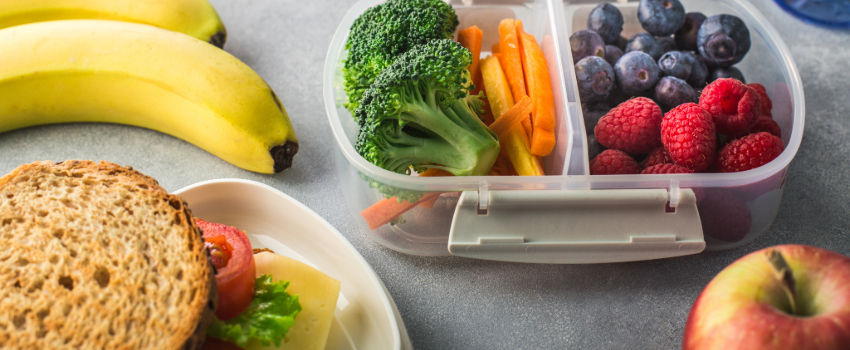Understanding Children’s Nutrition: Insights from a Nutrition Specialist

Parenthood comes with a multitude of questions, especially regarding children’s food and nutrition. How can you ensure your child is getting a balanced diet? How can you promote healthy eating habits at home? What should you do if your child is a picky eater?
We compiled a list of the most common questions about children’s nutrition, and asked Jill Weldon, New Horizon Academy’s Nutrition Specialist, to offer advice and practical tips for helping your child establish healthy eating habits.
10 Frequently Asked Questions About Kids’ Nutrition

Questions About Food and Nutrition
Q: How can I ensure that my child is getting a balanced diet?
A: To ensure your child is getting a balanced diet, make sure they are regularly consuming foods in all 5 food groups – fruits, vegetables, grains, protein, and dairy.
Q: When should I start introducing solid foods to my child?
A: Beginning around 6 months of age, solid foods may start to be added to a child’s diet if the infant is developmentally ready. Possible signs that an infant is ready can include:
- Infant can sit up in a highchair with good head control
- Infant shows interest in food
- Infant has doubled their birth weight, and weights 13 pounds or more
It is always best to work with your child’s medical professional on the introduction of solid foods.
Q: What are some healthy snack options for my toddler?
A: There are tons of healthy snack options that young kids can enjoy! A few of our favorite healthy snacks include:
- Avocado on a Whole Grain Bun
- Cottage Cheese and Diced Pears
- Hard Boiled Egg and Diced Fresh Fruit
- Cheddar Cheese Slice and Whole Grain Crackers
- Greek Yogurt and Berries
- Whole Grain/Low Sugar Cereal and Milk

Questions About Hydration
Q: How much water should my child be drinking?
A: The recommended daily water intake for infants and young children varies by age.
- 6-12 months: 1/2 – 1 cup per day
- 12-24 months: 1-4 cups per day
- 2-5 years: 1-5 cups per day
Here are 6 simple tips to help your child stay hydrated.
Q: How much milk should my child be drinking?
A: The recommended daily milk intake for infants and young children varies by age.
- 6-12 months: No milk
- 12-24 months: 2 cups per day
- 2-5 years: 2-3 cups per day
Children aged 1-2 years should be given unflavored whole milk. Children over 2 should be given unflavored non-fat or low-fat milk.
Q: Is it okay to give my child juice?
A: Milk and water are the healthiest choices for toddlers. Even 100% fruit juice can add unneeded calories and can harm your child’s teeth. Try adding fresh fruit to your child’s water if you want to add flavor.

Questions About Allergies and Food Sensitivities
Q: How do I know if my child has any food allergies or sensitivities?
A: Food allergies happen when the body reacts against harmless proteins in food. The reaction time is typically after the food allergen is eaten, and can be mild to severe. There is a difference between a food allergy and food intolerance or sensitivity.
Food Allergies
Food allergies cause more severe reactions than food intolerances. These reactions can be mild, severe, or life-threatening (anaphylaxis) which requires immediate medical attention. Common food allergy symptoms include:
- Skin (hives, itchy rashes, swelling, pale skin)
- Breathing (sneezing, wheezing, throat tightness)
- Stomach (nausea, vomiting, diarrhea)
- Lightheadedness
- Loss of consciousness
Food Intolerances and Sensitivities
Some foods may cause illness and can be confused with food allergies, but the immune system is not causing the problem. For example, lactose intolerance is often confused as being an allergy. A person with lactose intolerance has trouble digesting milk sugar, called lactose, causing stomachaches, bloating, and diarrhea, but that person is not allergic to milk.
Q: What are the most common food allergies to watch out for?
A: Some of the most common food allergies seen in children and adults include:
- Dairy
- Eggs
- Peanuts
- Soy
- Wheat
- Tree Nuts (walnuts, pistachios, pecans, cashews, etc.)
- Fish (tuna, salmon, cod, etc.)
- Shellfish (shrimp, lobster, etc.)
- Sesame
Peanuts, tree nuts, and seafood are the most common causes of severe reactions.
Q: What types of milk should I give my child if they have a dairy allergy or intolerance?
A: When a child cannot drink cow’s milk due to a food allergy or intolerance, a nutritionally equivalent plant-based milk is an option. Most plant-based milks such as oat milk, almond milk, and coconut milk are not nutritionally equivalent, because they lack nutrients like protein and calcium. They are not recommended for children to drink in place of dairy milk. However, soy milk and pea protein milk substitutions are nutritionally equivalent to cow’s milk, and are considered acceptable alternatives.

Questions About Picky Eating
Q: What do I do if my child is a picky eater and is resisting certain foods?
A: You don’t have to get into battles with your child if they will only limit themselves to certain foods. Instead, here are some helpful ways to encourage your child to try new foods.
- Hold back on enforcing the clean plate club. Do not force your child to eat something or finish everything. This will only create a battle leaving both you and your child feeling no sense of control. Children are more likely to try new foods if they have the choice of what and how much to eat. You provide the options, and your child will make the decision. It’s also important to remember that children don’t need a balanced meal for every meal of the day. Achieving a balance over a day or two is the goal. It’s also common for children to go in phases with what and how much they choose to eat as they grow and develop.
- Keep exposing the same foods. It often takes more than 15 tries before a child will even consider trying a new food and realize that they like it or would be open to trying it again. Be a role model – starting at an early age, sit together as a family and eat the same foods. Serve a food that you know your child will eat paired with a new food. Ask your child how they would like the food prepared or served, i.e. “Do you want the broccoli cooked or uncooked for dinner? What dip or melted cheese would you like on the broccoli?” Give your child two healthy options, i.e. “do you want a banana or an orange?”
- Cook more meals at home and get the children involved. Homemade chicken nuggets, for example, are a much healthier option than frozen or restaurant nuggets. Children can get involved by helping “coat” the chicken. Older children can help by cutting the chicken breasts into strips or chunks.
Have more questions about children’s nutrition? Submit a question in the conversation box below or explore our Food and Nutrition page!

New Horizon Academy is a nationally recognized early learning provider with 90+ schools in Minnesota, Colorado, Idaho, Iowa, and Kansas. Each of our schools serve hot meals and nutritious snacks every day at no extra cost to families. We have on-site cooks trained in nutrition, USDA guidelines, and proper portions for young children.
Schedule a tour to see inside our classrooms, meet our teachers and staff, and learn more about our food and nutrition program. Contact a New Horizon Academy childcare center near you today!


